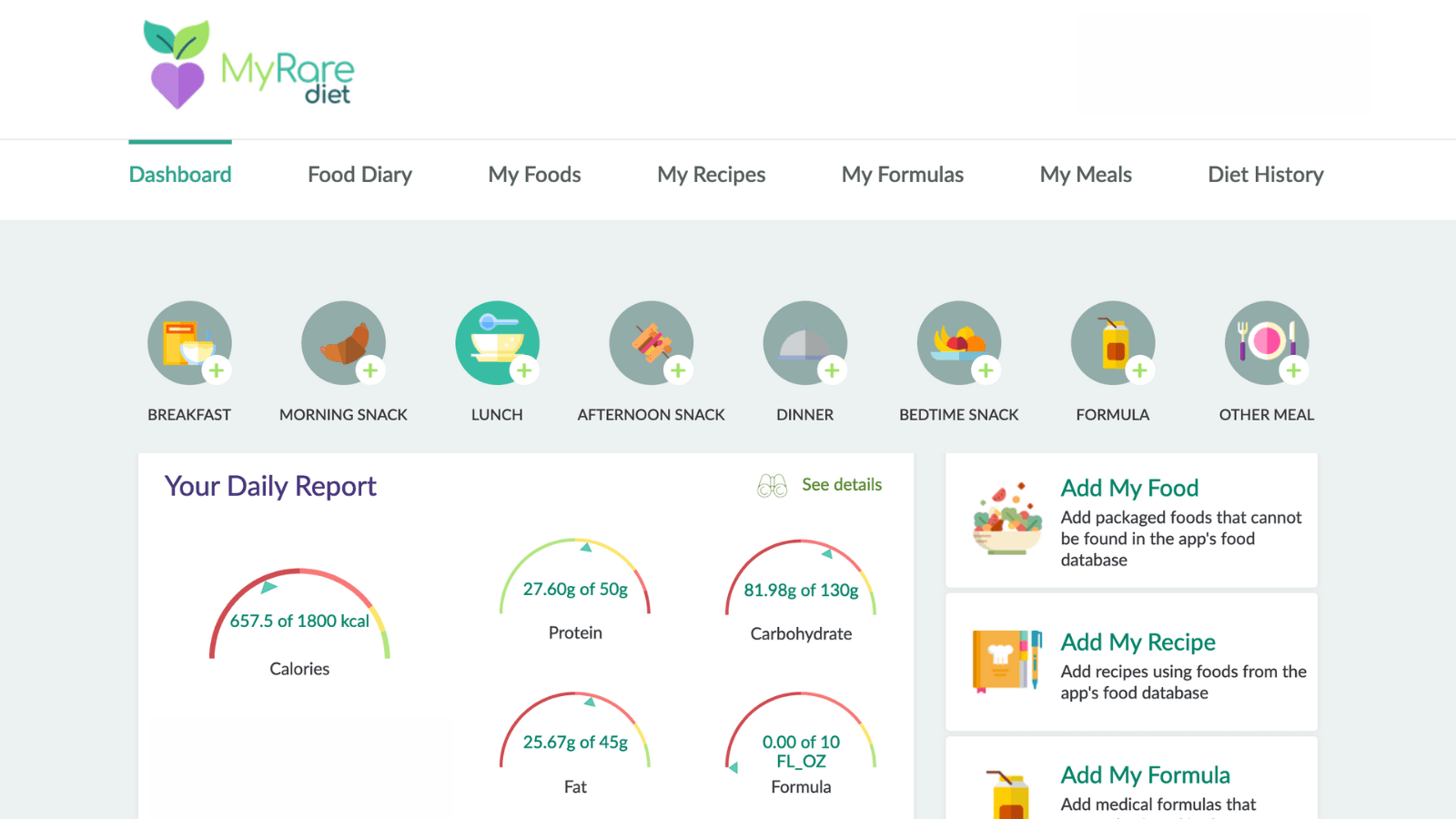
by Melanie Gillingham, PhD, RD, LD, Oregon Health and Science University
What is MyRareDiet?
MyRareDiet is a nutrition software application and mobile health tool being developed by the National Urea Cycle Disorders Foundation (NUCDF) and its partners that can be used in research, clinical trials and patient dietary management. It is being tested by users with the following inborn errors of metabolism (IEM) diagnoses: Urea Cycle Disorders (UCDs), Maple Syrup Urine Disease (MSUD), Methylmalonic Aciduria (MMA), and Propionic Aciduria (PA).
What is the history of MyRareDiet?
The initial idea for MyRareDiet was a collaboration between Debra Geary Hook, MS, RD, a metabolic dietitian, and Cynthia Le Mons, then executive director of NUCDF. They partnered with DerShung Yang, PhD of BrightOutcome Inc. to develop the initial app. BrightOutcome is a digital health technology company that specializes in innovative patient-reported outcomes (PRO)-based digital health solutions to promote self-management and improve outcomes.
Debra and Cindy recognized the need for a diet tracking app that could focus on tracking protein intake, specific amino acids of concern for various disorders, and medical foods and formulas. They also saw the need to have the data accessible for patients to share with their metabolic clinical team and the potential to use MyRareDiet in research studies.
Some high-level ideas Debra and Cindy formulated for the app were to “dial in” and help patients track how much protein they were consuming throughout the day. The tool’s home page features a dashboard with dials that move throughout the day as food choice are entered, showing progress toward nutrient goals. They wanted to make diet tracking easier for the patient and family and they wanted to help children and adolescents with IEMs take ownership and help manage their own dietary intake.
How was MyRareDiet developed?
The first phase of development was funded by a Phase 1 Small Business Innovation Research (SBIR) award (1R43HD097863) from the National Institutes of Health (NIH) in 2016. The team completed Phase 1 of the app development and applied for Phase 2 SBIR funding to validate the application they designed. The NIH awarded the Phase 2 SBIR funding (1R44HD107766) in 2022, but sadly, both Debra Hook and Cindy Le Mons passed away around that time. This tragic turn of events was a huge loss to our UCD and metabolic dietitian community. We miss Debra and Cindy’s passion and enthusiasm for MyRareDiet.
The SBIR award team, required to have an academic partner, eventually teamed with Dr. Melanie Gillingham and the bionutrition staff at Oregon Health & Science University (OHSU). NUCDF continues to lead the project and serves as the recruitment arm for the current validation study.
Where does the project now stand?
The MyRareDiet tool is not commercially available at this time. We are actively recruiting research participants to validate MyRareDiet against traditional 24-hour diet recalls. Our goal is to complete this project to honor the innovation and legacy of Debra Hook and Cindy Le Mons and fulfill their original goals to help the patient community.
There are several food tracking apps. What is different about MyRareDiet?
People with IEMs can choose from several diet tracking applications. We would encourage any patient to use the app that works well for them. There are some unique features of MyRareDiet you might consider when choosing to use MyRareDiet by participating in our validation study:
1. The software includes an extensive database of foods and their nutrient content imported from 1) the U.S. Department of Agriculture’s (USDA’s) FoodData Central database; 2) the Nutrient Data System for Research or NDSR from the National Coordinating Center at the University of Minnesota (NDSR is widely consider the largest, most accurate nutrient software by research dietitians across the globe); and 3) the Metabolic Pro database developed by metabolic dietitians from Genetic Metabolic Dietitians International (GMDI). This database includes many low protein foods and formulas commonly used in the IEM community. Other applications use different nutrient databases for nutrient analysis.
2. We have an option to enter your foods if our database does not include the foods you eat routinely. You can also set up your formula recipe or common meals. These entries are unique to you and do not enter the database as a whole for other people using the software to access. (For instance, user entered data is added to the nutrient database with MyFitnessPal and the accuracy of user entered foods is unknown.)
3. We have an option to share your data with your metabolic team through a clinician portal and we have a research study option so that MyRareDiet can be used for diet assessment in clinical trials.
4. We are currently validating MyRareDiet by comparing the app to a standard diet assessment method used in research: a 24-hour dietary recall. Many dietary apps that track nutrient intake do not validate the app against standard methods to demonstrate its accuracy and reliability. We will publish the results of our validation study when the study is complete to demonstrate how MyRareDiet compares to standard nutrition diet assessment methods.
5. All patient-entered data remains strictly confidential unless users choose to share their data with their clinical team. MyRareDiet will never sell or share patient information.
How can I join the MyRareDiet validation study?
To find out if you qualify to participate in our validation study, please complete the interest form located here: https://nucdf.org/mrd-contact/myraredietparticipation.html. A study coordinator will contact you.
